Related Research Articles
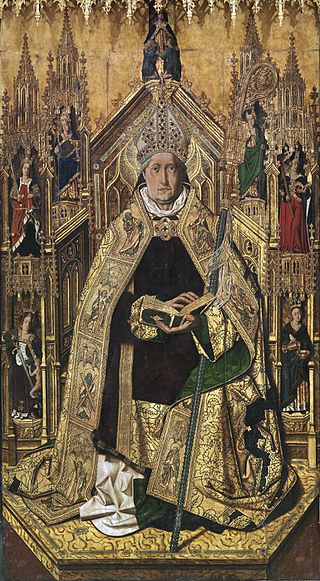
Abbot is an ecclesiastical title given to the head of an independent monastery for men in various Western Christian traditions. The name is derived from abba, the Aramaic form of the Hebrew ab, and means "father". The female equivalent is abbess.

Bernard of Clairvaux, O.Cist., venerated as Saint Bernard, was an abbot, mystic, co-founder of the Knights Templar, and a major leader in the reform of the Benedictines through the nascent Cistercian Order.
Pope Alexander II, born Anselm of Baggio, was the head of the Roman Catholic Church and ruler of the Papal States from 1061 to his death in 1073. Born in Milan, Anselm was deeply involved in the Pataria reform movement. Elected according to the terms of his predecessor's bull, In nomine Domini, Anselm's was the first election by the cardinals without the participation of the people and minor clergy of Rome. He also authorized the Norman Conquest of England in 1066.

Pope Honorius II, born Lamberto Scannabecchi, was head of the Catholic Church and ruler of the Papal States from 21 December 1124 to his death in 1130.
Pope Stephen IX was the Bishop of Rome and ruler of the Papal States from 3 August 1057 to his death on 29 March 1058. He was a member of the Ardenne-Verdun family, who ruled the Duchy of Lorraine, and started his ecclesiastical career as a canon in Liège. He was invited to Rome by Pope Leo IX, who made him chancellor in 1051 and one of three legates to Constantinople in 1054. The failure of their negotiations with Patriarch Michael I Cerularius of Constantinople and Archbishop Leo of Ohrid led to the permanent East–West Schism. He continued as chancellor to the next pope, Victor II, and was elected abbot of the Benedictine monastery of Montecassino.

Pope Victor III, was the head of the Catholic Church and ruler of the Papal States from 24 May 1086 to his death. He was the successor of Pope Gregory VII, yet his pontificate is far less notable than his time as Desiderius, the great abbot of Monte Cassino.
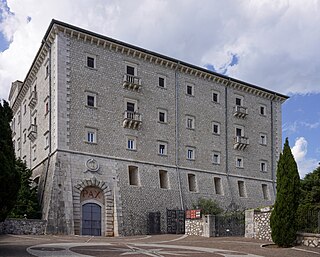
Monte Cassino is a rocky hill about 130 kilometres (80 mi) southeast of Rome, in the Latin Valley, Italy, 2 kilometres west of Cassino and at an elevation of 520 m (1,710 ft). Site of the Roman town of Casinum, it is widely known for its abbey, the first house of the Benedictine Order, having been established by Benedict of Nursia himself around 529. It was for the community of Monte Cassino that the Rule of Saint Benedict was composed.
Theobald of Bec was a Norman archbishop of Canterbury from 1139 to 1161. His exact birth date is unknown. Some time in the late 11th or early 12th century Theobald became a monk at the Abbey of Bec, rising to the position of abbot in 1137. King Stephen of England chose him to be Archbishop of Canterbury in 1138. Canterbury's claim to primacy over the Welsh ecclesiastics was resolved during Theobald's term of office when Pope Eugene III decided in 1148 in Canterbury's favour. Theobald faced challenges to his authority from a subordinate bishop, Henry of Blois, Bishop of Winchester and King Stephen's younger brother, and his relationship with King Stephen was turbulent. On one occasion Stephen forbade him from attending a papal council, but Theobald defied the king, which resulted in the confiscation of his property and temporary exile. Theobald's relations with his cathedral clergy and the monastic houses in his archdiocese were also difficult.

Fritzlar is a small town in the Schwalm-Eder district in northern Hesse, Germany, 160 km (99 mi) north of Frankfurt, with a storied history.

Odo of Cluny was the second abbot of Cluny.
A commendatory abbot is an ecclesiastic, or sometimes a layman, who holds an abbey in commendam, drawing its revenues but not exercising any authority over its inner monastic discipline. If a commendatory abbot is an ecclesiastic, however, he may have limited jurisdiction.

Cluny Abbey is a former Benedictine monastery in Cluny, Saône-et-Loire, France. It was dedicated to Saints Peter and Paul.

Virgil, also spelled Vergil, Vergilius, Virgilius, Feirgil or Fearghal, was an Irish priest and early astronomer. He left Ireland around 745, intending to visit the Holy Land; but, like many of his countrymen, he settled in Francia. Virgil served as abbot of Aghaboe, bishop of Ossory and later bishop of Salzburg. He was called "the Apostle of Carinthia" and "the geometer".

Farfa Abbey is a territorial abbey in northern Lazio, central Italy. In the Middle Ages, it was one of the richest and most famous abbeys in Italy. It belongs to the Benedictine Order and is located about 60 km (37 mi) from Rome, in the comune (municipality) of Fara Sabina, of which it is also a frazione (hamlet).
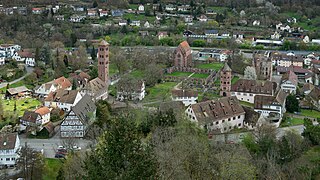
Hirsau Abbey, formerly known as Hirschau Abbey, was once one of the most important Benedictine abbeys of Germany. It is located in the Hirsau borough of Calw on the northern slopes of the Black Forest mountain range, in the present-day state of Baden-Württemberg. In the 11th and 12th century, the monastery was a centre of the Cluniac Reforms, implemented as "Hirsau Reforms" in the German lands by William of Hirsau. The complex was devastated during the War of the Palatine Succession in 1692 and not rebuilt. The ruins served as a quarry for a period of time.

The Bursfelde Congregation, also called Bursfelde Union, was a union of predominantly west and central German Benedictine monasteries, of both men and women, working for the reform of Benedictine practice. Named after Bursfelde Abbey, it included over 100 monasteries in middle Europe.

Mondsee Abbey was a Benedictine monastery in Mondsee in Upper Austria.
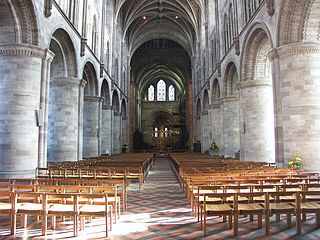
Gilbert Foliot was a medieval English monk and prelate, successively Abbot of Gloucester, Bishop of Hereford and Bishop of London. Born to an ecclesiastical family, he became a monk at Cluny Abbey in France at about the age of twenty. After holding two posts as prior in the Cluniac order he was appointed Abbot of Gloucester Abbey in 1139, a promotion influenced by his kinsman Miles of Gloucester. During his tenure as abbot he acquired additional land for the abbey, and may have helped to fabricate some charters—legal deeds attesting property ownership—to gain advantage in a dispute with the Archbishops of York. Although Foliot recognised Stephen as the King of England, he may have also sympathised with the Empress Matilda's claim to the throne. He joined Matilda's supporters after her forces captured Stephen, and continued to write letters in support of Matilda even after Stephen's release.
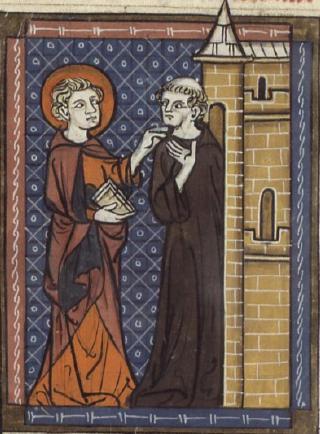
Saint Fursey was an Irish monk who did much to establish Christianity throughout the British Isles and particularly in East Anglia. He reportedly experienced angelic visions of the afterlife. Fursey is one of the Four Comely Saints.
Saint Berno of Cluny or Berno of Baume was the first abbot of Cluny from its foundation in 909 until he died in 927. He began the tradition of the Cluniac reforms which his successors spread across Europe.
References
![]() This article incorporates text from a publication now in the public domain : "Froucester, Walter". Dictionary of National Biography . London: Smith, Elder & Co. 1885–1900.
This article incorporates text from a publication now in the public domain : "Froucester, Walter". Dictionary of National Biography . London: Smith, Elder & Co. 1885–1900.